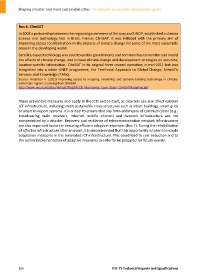Page 574 - Shaping smarter and more sustainable cities - Striving for sustainable development goals
P. 574
Box 6. ClimSAT
In 2008 a partnership between the regional government of Brittany and UNDP, established a climate
science and technology hub in Brest, France: ClimSAT. It was initiated with the primary aim of
improving access to information on the impacts of climate change for some of the most vulnerable
areas in the developing world.
Satellite‐based technology was used to enable governments and communities to monitor and model
the effects of climate change, and to base climate change and development strategies on accurate,
location‐specific information. ClimSAT in its original form ceased operation in mid‐2011 but was
integrated into a wider UNEP programme, the Territorial Approach to Global Change, Scientific
Services and Knowledge (TASK).
Source: Anderton K. (2011) Improving access to mapping, modelling and scenario‐building technology in climate‐
vulnerable regions: Learning from ClimSAT.
http://www.niccd.org/sites/default/files/NICCD_Monitoring_Case_Study_ClimSATModelling.pdf
These preventive measures also apply to the ICTs sector itself, as disasters can also affect existent
ICT infrastructure, including smart sustainable cities structures such as smart buildings, smart grids
or smart transport systems. It is critical to ensure that any form and means of communication (e.g.,
broadcasting radio receivers, Internet, mobile phones) and network infrastructure are not
compromised by a disaster. Recovery and resilience of telecommunication network infrastructure
are also important factors in ensuring efficient adaptive responses (Box 7). During the rehabilitation
of affected infrastructure after an event, it is recommended that this opportunity is taken to include
adaptation measures in the renovated ICT infrastructure. This could lead to cost reduction and to
the earlier implementation of adaptive measures in order to be prepared for future events.
564 ITU‐T's Technical Reports and Specifications

